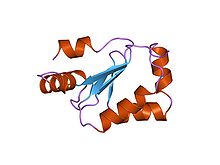| Glutaredoxin | |||||||||
|---|---|---|---|---|---|---|---|---|---|
 | |||||||||
| Identifiers | |||||||||
| Symbol | Glutaredoxin | ||||||||
| Pfam | PF00462 | ||||||||
| Pfam clan | CL0172 | ||||||||
| InterPro | IPR002109 | ||||||||
| PROSITE | PDOC00173 | ||||||||
| SCOP2 | 1kte / SCOPe / SUPFAM | ||||||||
| OPM superfamily | 131 | ||||||||
| OPM protein | 1z9h | ||||||||
| CDD | cd02066 | ||||||||
| |||||||||
Glutaredoxins (also known as Thioltransferase) are small redox enzymes of approximately one hundred amino-acid residues that use glutathione as a cofactor. In humans this oxidation repair enzyme is also known to participate in many cellular functions, including redox signaling and regulation of glucose metabolism. Glutaredoxins are oxidized by substrates, and reduced non-enzymatically by glutathione. In contrast to thioredoxins, which are reduced by thioredoxin reductase, no oxidoreductase exists that specifically reduces glutaredoxins. Instead, glutaredoxins are reduced by the oxidation of glutathione. Reduced glutathione is then regenerated by glutathione reductase. Together these components compose the glutathione system.
Like thioredoxin, which functions in a similar way, glutaredoxin possesses an active centre disulfide bond. It exists in either a reduced or an oxidized form where the two cysteine residues are linked in an intramolecular disulfide bond. Glutaredoxins function as electron carriers in the glutathione-dependent synthesis of deoxyribonucleotides by the enzyme ribonucleotide reductase. Moreover, GRX act in antioxidant defense by reducing dehydroascorbate, peroxiredoxins, and methionine sulfoxide reductase. Beside their function in antioxidant defense, bacterial and plant GRX were shown to bind iron-sulfur clusters and to deliver the cluster to enzymes on demand.
In viruses
Glutaredoxin has been sequenced in a variety of viruses. On the basis of extensive sequence similarity, it has been proposed that Vaccinia virus protein O2L is, it seems, a glutaredoxin. Bacteriophage T4 thioredoxin seems to be evolution-related. In position 5 of the pattern T4, thioredoxin has Val instead of Pro.
In plants
Approximately 30 GRX isoforms are described in the model plant Arabidopsis thaliana and 48 in Oryza sativa L. According to their redox-active centre, they are subgrouped in six classes of the CSY-, CGFS-, CC-type and 3 groups with additional domain of unknown function. The CC-type GRXs are only found in higher plants. In Arabidopsis GRXs are involved in flower development and Salicylic acid signalling.
Subfamilies
Human proteins containing this domain
GLRX; GLRX2; GLRX3; GLRX5; PTGES2
References
- Gleason FK, Holmgren A (December 1988). "Thioredoxin and related proteins in procaryotes". FEMS Microbiology Reviews. 54 (4): 271–97. doi:10.1111/j.1574-6968.1988.tb02747.x. PMID 3152490.
- Holmgren A (April 1988). "Thioredoxin and glutaredoxin: small multi-functional redox proteins with active-site disulphide bonds". Biochemical Society Transactions. 16 (2): 95–6. doi:10.1042/bst0160095. PMID 3286320.
- Holmgren A (August 1989). "Thioredoxin and glutaredoxin systems". The Journal of Biological Chemistry. 264 (24): 13963–6. doi:10.1016/S0021-9258(18)71625-6. PMID 2668278.
- Xing KY, Lou MF (December 2010). "Effect of age on the thioltransferase (glutaredoxin) and thioredoxin systems in the human lens". Investigative Ophthalmology & Visual Science. 51 (12): 6598–604. doi:10.1167/iovs.10-5672. PMC 3055771. PMID 20610843.
- Berndt C, Lillig CH, Holmgren A (April 2008). "Thioredoxins and glutaredoxins as facilitators of protein folding". Biochimica et Biophysica Acta (BBA) - Molecular Cell Research. Redox regulation of protein folding. 1783 (4): 641–50. doi:10.1016/j.bbamcr.2008.02.003. PMID 18331844.
- ^ Fernandes AP, Holmgren A (February 2004). "Glutaredoxins: glutathione-dependent redox enzymes with functions far beyond a simple thioredoxin backup system". Antioxidants & Redox Signaling. 6 (1): 63–74. doi:10.1089/152308604771978354. PMID 14713336.
- Foloppe N, Nilsson L (February 2004). "The glutaredoxin -C-P-Y-C- motif: influence of peripheral residues". Structure. 12 (2): 289–300. doi:10.1016/j.str.2004.01.009. PMID 14962389.
- ^ Rouhier N, Lemaire SD, Jacquot JP (2008). "The role of glutathione in photosynthetic organisms: emerging functions for glutaredoxins and glutathionylation" (PDF). Annual Review of Plant Biology. 59: 143–66. doi:10.1146/annurev.arplant.59.032607.092811. PMID 18444899.
- Johnson GP, Goebel SJ, Perkus ME, Davis SW, Winslow JP, Paoletti E (March 1991). "Vaccinia virus encodes a protein with similarity to glutaredoxins". Virology. 181 (1): 378–81. doi:10.1016/0042-6822(91)90508-9. PMID 1994586.
External links
- Enzyme database entry
- Glutaredoxins at the U.S. National Library of Medicine Medical Subject Headings (MeSH)
| Other oxidoreductases (EC 1.15–1.21) | |
|---|---|
| 1.15: Acting on superoxide as acceptor | |
| 1.16: Oxidizing metal ions | |
| 1.17: Acting on CH or CH2 groups | |
| 1.18: Acting on iron–sulfur proteins as donors | |
| 1.19: Acting on reduced flavodoxin as donor | |
| 1.20: Acting on phosphorus or arsenic in donors | |
| 1.21: Acting on X-H and Y-H to form an X-Y bond | |
| Enzymes | |
|---|---|
| Activity | |
| Regulation | |
| Classification | |
| Kinetics | |
| Types |
|
This EC 1.20 enzyme-related article is a stub. You can help Misplaced Pages by expanding it. |